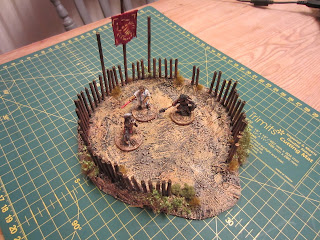 |
| Gladius vs Trident |
 |
| Neptune takes an interest. |
 |
| Retiarius on the wrong end of a catastrophic bleed. |
Having painted up the typical Murmillio (M) v Retiarius (R) gladiator figures, I gave Habet Hoc Habet a good "kick of the tyres". First my novice gladiators were allocated basic attributes for strength, size, health, speed, agility, luck and popularity. To these were added standard skills for grappling, running and throwing rocks. 3D3 worth of additional attributes and skills could be bought equipping my mini-pugilists with the means to handle their primary weapons - sword and shield for "M" and trident and net for "R".
The initiative phase provided "action" cards from a standard card-deck. Novices receive two cards each. My Retiarius turned 8 of clubs then a joker gaining another card, an ace, gaining yet another card which was 9 of clubs. Murmillo's hand consisted of king of hearts followed by 9 of spades. These cards gave "M" the first two actions with which he first charged his opponent to deliver a sword attack. "R's" ace however, allows him to interrupt "M's" charge with a trident thrust which "M" successfully defends. "M" develops his sword attack achieving a "hit" with his size and strength bonus augmented by a very high dice roll. "R" failed his blocking roll and therefore "M's" gladius hit home with the force of a "mighty blow". The cut falls on Retiarius' right leg creating a catastrophic bleed. His movement is reduced to a crawl and he is pronounced with 2D3 actions before he is defeated.
Retiarius seizes his last gasp chance by co-ordinating a net and trident assault. His net is cast with a natural 9 versus 4 meaning Murmillo is ensnared. Retiarius holds on for two more rounds before weakening, allowing Murmillo to get free. "R's" trident attack fails as his weapon is parried by "M's" gladius. Retiarius sinks to his knees exhausted to the point of collapse. The day belongs to Murmillo!
Aye,
Rusty Pilum
Retiarius seizes his last gasp chance by co-ordinating a net and trident assault. His net is cast with a natural 9 versus 4 meaning Murmillo is ensnared. Retiarius holds on for two more rounds before weakening, allowing Murmillo to get free. "R's" trident attack fails as his weapon is parried by "M's" gladius. Retiarius sinks to his knees exhausted to the point of collapse. The day belongs to Murmillo!
Aye,
Rusty Pilum
























